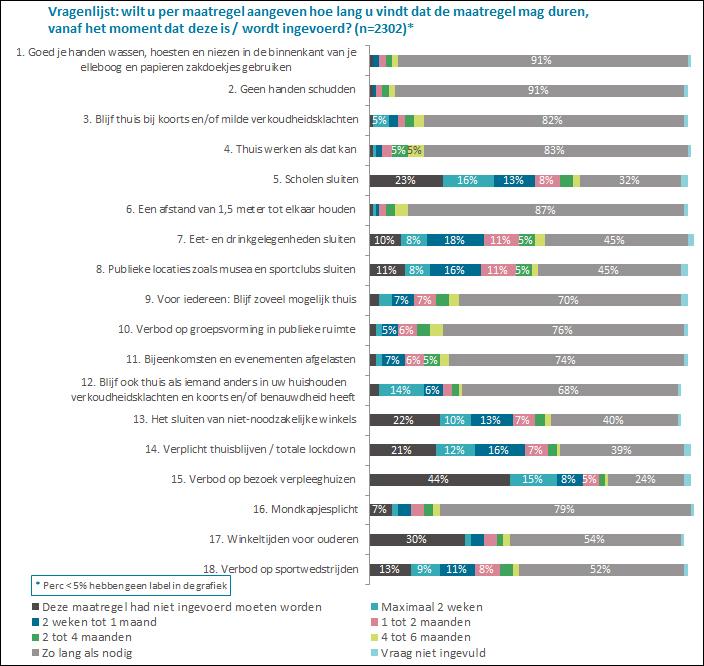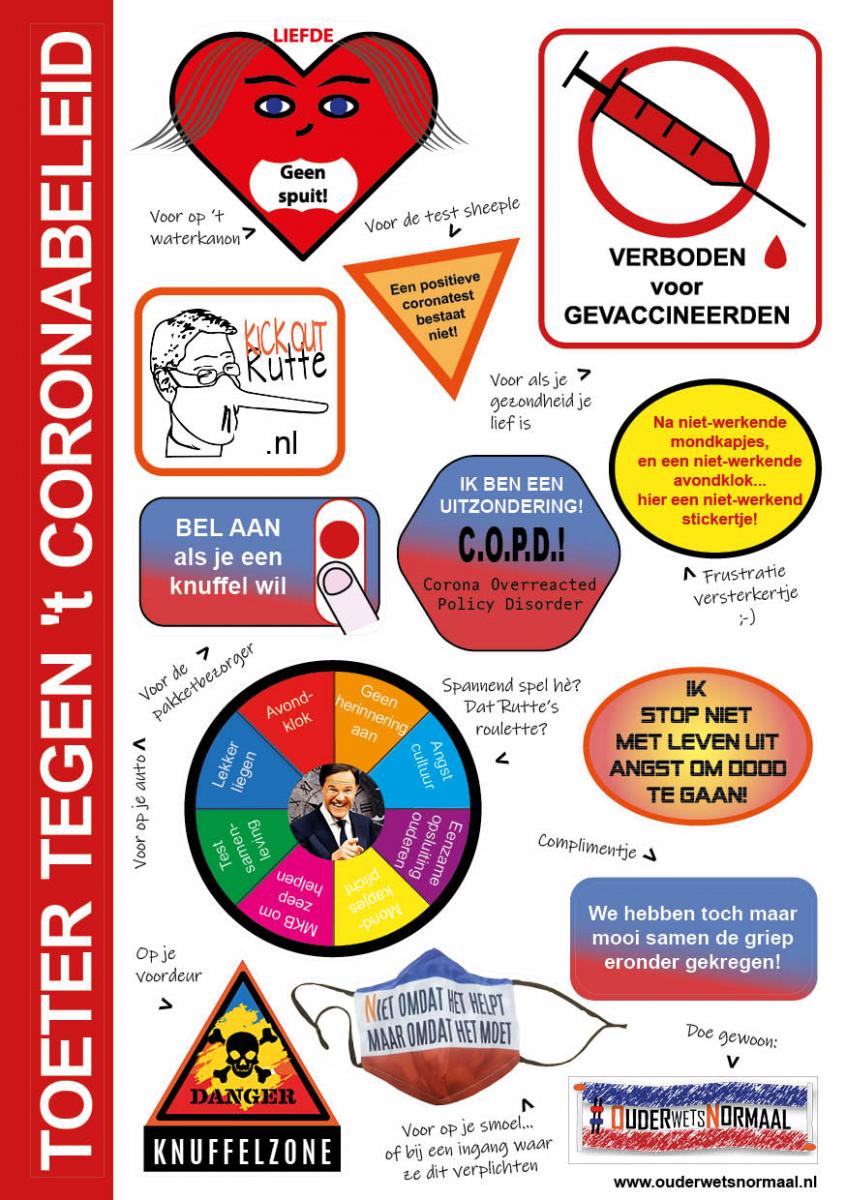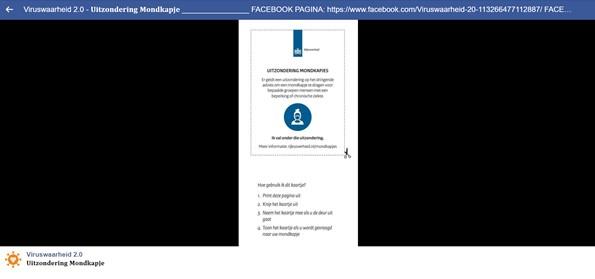
Infrapolitics and the Subversion of the Public Transcript by Dutch Covid-19 Measure Dissidents
The Dutch institute for research on healthcare, called Nivel, has been monitoring the acceptance of Covid-19 measures under the Dutch population and has concluded that acceptance for most of the taken measures is still large for every group in society. This is also reflected in the chart released by Nivel as shown in figure 1. For example, the 16th item on the survey that is about the measure that obligates you to wear a face mask shows that 79 per cent of respondents believe the measure should last as long as necessary. This group is represented with the colour grey. There are similar results for the measures 'stay at home when experiencing symptoms of a fever and/or mild symptoms of a cold' (item 3) and 'a ban on assembly in public spaces' (item 10). (For a full translation of the figure, please check the footnotes.)
However, although the governmental Covid-19 discourse has hegemonic aspirations, there are still many people who oppose this message and the resulting measures. This is reflected in the chart in figure 1; every colon, which presents public opinion on how long a specific measure should stay in place, features (at least) a small percentage of respondents who believe that the measure should not have been instated in the first place. This group is represented by the colour dark brown.

Figure 1) Acceptance of the duration of Covid-19 measures by Dutch citizens, measuring moment October 15th 2020 - October 22th 2020*
This minority group, which consists of people who believe the government is overstepping the boundaries of its power and people who (in varying degrees) deny the existence or severity of the virus (Kuiper, 2020), cannot easily openly reject the Covid-19 measures to express their dissent in fear of being (socially) sanctioned. This paper will show how this minority group can, through infrapolitical practices, oppose the hegemony of the governmental Covid-19 discourse.
Method
First, Scott’s (1990) four varieties of political discourse amongst subordinate groups will be explained with examples from the group of Covid-19 measure dissidents. This will prove that this group can be analysed using Scott’s ‘Domination and the Art of Resistance’ (1990). In the remainder of the article, we will then zoom in on a political discourse called 'infrapolitics' mentioned by Scott to analyse a few examples of practices used by Dutch citizens to oppose the Covid-19 measures.
The short timespan of this research project made it impossible to build up the necessary rapport needed to gain access to the online spaces where people’s hidden transcripts are expressed, which is why this article relies on a variety of data sources and will focus on actions perceivable in public spaces.
What Are ‘Hidden Transcripts’ and ‘Infrapolitics’?
Ordinarily, ideas, images, discourses and ideologies are hegemonic when they are experienced as ‘normal’ or ‘neutral’. However, in ‘Domination and the Art of Resistance’ (1990), James C. Scott brings more nuance to this idea by explaining that hegemony can be a ‘public transcript’, which gives the appearance of homogeneity of public opinion while hiding any dissenting opinions, aka ‘hidden transcripts’. Groups with these anti-hegemonic hidden transcripts pretend to follow the social and cultural rules of the public transcript to be protected from sanctions while disagreeing with the hegemonical ideological ideas that inform the rules which they must follow.
Covid-19 measure dissidents are not merely a minority, but see themselves as a ‘subordinate’ group with the government and health institutions as their oppressors. This is mirrored in the talking points of vocal anti-measure groups, such as VirusWaarheid. One of these talking points is that democratic rights, including the right to your own beliefs and opinions, have slowly been rolled back by the government in recent times; a process that has been exacerbated by the pandemic. Other common talking points of these dissidents include: the virus is presented to be more dangerous than it actually is so health and government institutions can exert more power over the population, and traditional news is influenced by the government and is censoring the voices of Covid-19 sceptics. This view of themselves as an oppressed group is often paired with a feeling of intellectual superiority over those who do not agree with their set of beliefs; those who follow the hegemonical discourse are ‘sheep’ and those who do not have ‘woken up’ and are now ‘awake’. This distances the group even further from those who follow the hegemonical discourse.
Scott denotes four varieties of political discourse amongst subordinate groups that we can distinguish amongst the group of people who are against the Covid-19 measures:
The first of these, which is the safest and most public form of discourse, makes use of the rhetorical self-image of the elites to find representation for minority needs within the prevailing ideology. For example, one of the core values of the biggest Dutch political party VVD is that everyone should have as much personal freedom as possible. When people appeal to this core value, the VVD might feel inclined to ease restrictions.
A second form of political discourse is that of the hidden transcript itself. “Here, offstage, where subordinates may gather outside the intimidating gaze of power, a sharply dissonant political culture is possible.” (Scott, 1990, p. 18). Although the government tries to socialize the population into accepting the public transcript through government and health channels, there are certain places where it cannot reach. Online spaces in particular, where you can remain anonymous, such as Facebook groups, can function as private spheres in which a hidden transcript can freely be expressed. This is further reflected in research done by the RIVM (The Dutch institute for public health and the environment) on what sources people used in making the decision to vaccinate or not. The research shows that people who want to be vaccinated indicate that governmental sources are important in their decision, whereas those who do not want to be vaccinated point to non-governmental sources as their primary sources for making their decision.
Furthermore, The police can not enter someone’s home to check if the Covid-19 regulations are followed without the permission of an inhabitant, which makes it harder to sanction actions that take place inside of the home that break the Covid-19 regulations. This makes the home another private sphere where people can subvert the government’s hegemonical discourse and express their hidden transcript. Opposing the Covid-19 measures in this space can be done by flipping the rules of the public transcript. Following the 1,5-meter-distance-rule, for example, is discouraged by two of the stickers on the sticker sheet displayed in figure 2; one warns ‘Danger: hugging zone’ (‘Danger: knuffelzone’), the other suggests ‘RING THE BELL if you want a hug’ (‘BEL AAN als je een knuffel wilt’). The added notes in black pointing to these stickers encourage the buyer of the sticker sheet to place these two stickers near their front door.

Figure 2) Stickersheet to protest the Covid-19 regulations with
Another type of political discourse is called ‘infrapolitics’. “This is a politics of disguise and anonymity that takes place in public view but is designed to have a double meaning or to shield the identity of the actors.” (Scott, 1990, p. 19). This includes low-profile practices of passive noncompliance, subtle sabotage, evasion, and deception. This political discourse is the main focus of this paper and key to how the hegemonic, governmental Covid-19 discourse can be opposed.
The last and final form of political discourse is the rupture of the hidden transcript. This happens in moments of open defiance, often resulting in harsh sanctions or further breaches of the public transcript. In the case of people who are against the Covid-19 measures, it can be useful to make a distinction between individual acts of defiance and acts of defiance by a collective. Individuals who breach the public transcript can be met with indifference or sanctions, such as fines for staying out after the curfew, being escorted out of a store for not wearing a mask, etc. However, a collective of protesters breaching the public transcript is acceptable as long as protesters do not breach the normative rules and governmental regulations for protesting. These rules are slightly more lenient when it comes to the specific regulations about assembly in times of Covid-19 than the general Covid-19 restrictions. When governmental regulations are breached, protesters can be met with harsh retaliation, as was the case with the protest on Het Malieveld in March of 2021, which is currently under investigation from Amnesty International for disproportional police violence (Van de Wier, 2021).
Infrapolitical Practices by Dutch Covid-19 Measure Dissidents
Some actions against the regulations by Dutch Covid-19 measure dissidents can be analysed through the previously mentioned lens of infrapolitics. The different ways in which these practices can be interpreted and/or the way in which they protect the anonymity of the actor makes them difficult to sanction.
The first example of these practices is incorrectly wearing a face mask. There have been plenty of public PSA’s by the government on how to wear face masks correctly and yet there are still a lot of people who choose to wear them incorrectly or wear alternatives to the face mask that are not technically allowed, such as visors (face shields) or scarfs. Some of the most common ways to wear a mask incorrectly are wearing it under your chin, wearing it under your nose, having it only covering your nose or having it dangle from your ear (Geddes, 2020).
These dubious ways of wearing a mask do not necessarily indicate whether or not someone believes in the existence and severity of the virus but do show a lack of concern for the regulations. Furthermore, these deliberately deceitful ways of wearing a mask can easily be corrected by the actor (unlike when wearing a visor or scarf) or lied about when coming in contact with police, which protects the actor from being sanctioned. This is also speculated by Tobol in his research on whether or not people who wear their mask incorrectly are more likely to lie. “This supports our hypothesis that passers-by who wore their mask improperly rather than not wearing it at all, apparently for the purpose of lying to a police officer that their mask unnoticeably slipped down, are greater liars than other passers-by strolling the streets during the coronavirus pandemic.” (Tobol, 2020)
A second way in which people can and have been avoiding following the public mask-wearing policy is through faking a medical condition which grants them a medical exemption for wearing a facemask in public indoor spaces. This tactic is easy to get away with because:
a) Owners and workers of public spaces can only bar you from entering if you cannot show proof of your medical condition. But, this can be done in numerous, easily replicable ways, such as showing a medical aid or showing an exemption card, which is freely accessible to everyone at rijksoverheid.nl. This exemption card is also widely shared amongst groups that deny (in various degrees) the existence of Covid-19, such as VirusWaarheid as shown in figure 3.

Figure 3) The group VirusWaarheid sharing the exemption card on their Facebookpage
b) Only regulation enforcers such as police officers or BOA’s, who are investigative officers that are not part of the police and are more limited in the actions they may take, are allowed to fine people and the risk of running into them in privately owned public spaces is slim. In practice, this means that the chance of being sanctioned for not wearing a face mask in a public space is very small.
Another way in which Dutch citizens protest the Covid-19 regulations is by displaying the Dutch flag upside down. (You can see this usage of the flag on the face mask sticker in figure 2, which combines the upside down flag with the statement: ‘Not because it helps, but because it’s mandatory.') The upside down flag has historically been used by other protest groups to protest against the government and is not illegal. The colours of the flag have symbolic meaning: red symbolizes the people, white the church and blue the elite (or aristocracy). Therefore, turning the flag around symbolizes the oppression of the people by the elite ("Waarom de omgekeerde vlag oprukt", 2020). This example is more overt than the previous two examples because the meaning of waving the flag upside down is not specific to Covid-19 protests and is widely known. However, what makes this an infrapolitical action is its usage on the 4th and 5th of may this year when its salient meaning was used to cloak a different, associative meaning.
The 4th of May is traditionally the day on which victims of war are mourned, which can be done by waving the Dutch flag half-mast. Meanwhile, on the 5th of May the liberation of The Netherlands during WWII as well as freedom, democracy and human rights are celebrated. Although some Covid-19 measure dissidents only intend to question the value of freedom during these two days by using the flag upside down, others used the upsidedown flag to draw an associative parallel between governmental Covid-19 regulations and governmental practices in early Nazi Germany. This parallel has also been made in more obvious ways by Covid-19 measure dissidents, such as in a blogpost by VirusWaarheid which compares ‘Wappies’ (those who do not believe in the existence of Covid-19) with the persecuted Weiβe Rose group, by Willem Engel, who compared Covid-19 regulations to yellow badges and by graffiti on bunkers in Zeeland which combined yellow badges with the word Covid, which you can see in figure 4.

Figure 4) Yellow badge with the text 'Covid' graffitied on a bunker in Zeeland
‘Flipping the Script’ with Infrapolitics
To summarize, although Covid-19 measure dissidents are not withheld from the right to protest like the examples of subordinate groups Scott names in ‘Domination and the Art of Resistance’ (1990), they do need to comply with the (more lenient) rules imposed upon them by the public transcript when protesting and can be analysed through the four political discourses of subordinate groups. This group can express their hidden transcript freely in private spheres such as online groups or the privacy of their own home but needs to comply with the Covid-19 measures in public spaces where the power of the government can reach.
Infrapolitics provides these people with a way to oppose the governmentally imposed public transcript while also ensuring a minimal risk of sanctions. The goal of subverting the hegemonical discourse is what all infrapolitical practices have in common, but as shown, they can be diverse in nature; some, such as wearing your face mask in an incorrect way, are deliberately deceitful, while others, such as the usage of an upside-down Dutch flag on the 4th and 5th of May, can have a double meaning.
Other than being a way to show dissent with a low risk of being sanctioned, the infrapolitical actions by this group also have other functions and goals. First of all, it can alleviate some of the frustration one feels with ‘the oppressor’; a covid-19 measure dissident may not be able to directly change the regulation imposed by the government, but not following the rules may feel like a personal victory or a small stab at the government. Secondly, some forms of expression of the hidden transcript (like infrapolitics) by an individual may index their identity as a Covid-19 measure dissident to those with the same set of beliefs while remaining unnoticed by those outside of the group, which allows people with a similar ideology to connect. This set of shared practices, indexes and connections creates a sense of community. Lastly and most importantly, infrapolitical actions challenge the hegemonical discourse with the potential of changing it. The discourse loses much of its power to regulate the conduct of others when an increasing group of people disregard these regulations. Therefore, infrapolitical actions are part of the groundwork for a change of the hegemonical discourse.
There are many more types of infrapolitical practices, which were not elaborated upon due to the limitations and length of this article, which is why I want to end this article with some recommendations for further research. First of all, it is very likely that Covid-19 will remain part of our lives in one way or another, which is why it could be fruitful to do further research on infrapolitical practices by those who oppose the measures. In particular, this framework could be used to analyse infrapolitical practices that will inevitably occur when new regulations are put in place, such as the vaccine passport. Secondly and lastly, Scott describes fantasies of revenge and breaking the public transcript as the basis of the hidden transcript: “At its most elementary level the hidden transcript represents an acting out in fantasy -and occasionally in secretive practice- of the anger and reciprocal aggression denied by the presence of domination.” (Scott, 1990, p. 37-38). It would therefore be interesting to do research on the fantasies at the basis of the hidden transcript of Covid-19 measure dissidents.-
*Title: 'Questionaire: Would you indicate how long the measure should last, in your opinion, from the moment it is implemented? (n=2302)' List of measures: '1. Washing your hands, sneezing and coughing in your elbow, and using a tissue’, '2. Not shaking hands', '3. Stay at home when experiencing symptoms of fever and or mild symptoms of a cold’, '4. Working at home when able’, '5. Closing schools’, '6. keeping 1.5-metre distance’, '7. Closing the catering industry’, '8. Close public spaces such as museums and sports clubs', '9. Everyone stays home as much as possible’, '10. a ban on assembly in public spaces’, '11. cancel events and meetings’, '12. Stay at home when someone in your household experiences symptoms of a cold and has a fever and/or experiences shortness of breath’, '13. closing non-essential stores’, '14. obligatory staying at home/total lockdown’, '15. a ban on visiting nursing homes', '16. obligation to wear a face mask’, '17. specific shopping times for the elderly’, '18. a ban on sporting competitions’. Colour-coded categories of answer options: Dark brown: 'this measure should not have been instated in the first place', teal: 'max 2 weeks', dark blue: '2-4 weeks', pink: '1-2 months', dark green: '2-4 months', light green: '4-6 months', grey: 'as long as needed' and light blue: 'did not answer the question.'
References
Geddes, L. (2020, October 2). The most common ways we're wearing face masks incorrectly. The Guardian.
Kuiper, R. (2020, June 27). Wat drijft de anti-1,5-meterbetogers? ‘Ze dringen hiermee in de poriën van de samenleving door’. De Volkskrant.
Scott, J. C. (1990). Domination and the arts of resistance. Hidden transcripts. Yale University Press
Tobol, Y., Siniver, E., Yaniv, G. (2020). Dishonesty and mandatory mask wearing in the COVID-19 pandemic. Economics Letters, 197. DOI: https://doi.org/10.1016/j.econlet.2020.109617.
Van de Wier, M. (2021, March 15). Amnesty: Het politieoptreden bij het coronaprotest op het Malieveld was levensgevaarlijk. Trouw.
Waarom de omgekeerde vlag oprukt. (2020, July 6). Het Parool.